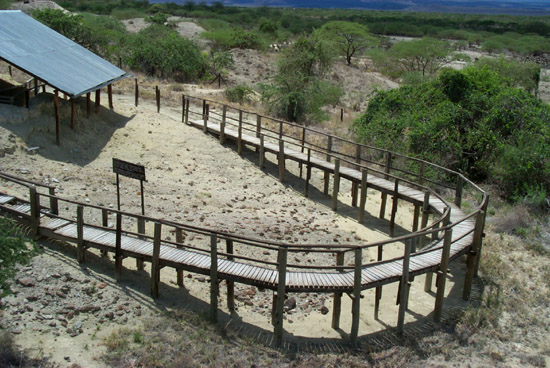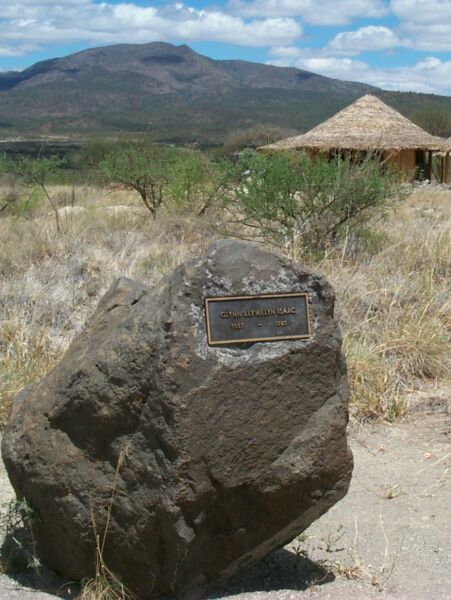William H. Calvin, A Brain for All Seasons: Human Evolution and Abrupt Climate Change (University of Chicago Press, 2002). See also http://WilliamCalvin.com/BrainForAllSeasons/Olor.htm. ISBN 0-226-09201-1 (cloth) GN21.xxx0 Available from amazon.com or University of Chicago Press. |
William H. Calvin
University of Washington |
|
We
were driving along a nice, flat stretch of road, and I looked around
to see that both sides of the road were flat for a long way back.
Aha, I said, drawing it to the attention of the expatriate
cousin. We are, I
announced, in the midst of another former lake bed.
Lakes shrink and expand as droughts come and go, so shorelines
migrate. There’s
another kind of change, too: most
shallow lakes silt up eventually, if something doesn’t pull the plug
before then. That’s why
it’s so flat here. There’s
a wonderful example to the west of Wilson Airport in Nairobi, a
light-green-surfaced pond” with dark-green woods surrounding it –
except that the “pond” now has a road running across it.
And it’s probably not a floating pontoon bridge, either.
We’re on our way to visit Olorgesailie, which is right on the
edge of a basin that held a lake until it lost part of its rim to
earth settling. About a
million years ago, it contained Lake Olorgesailie (a quite large
freshwater lake, over a hundred km2, now vanished), much
like the still-wet ones in the Rift Valley north of Nairobi that
we’ll visit starting tomorrow.
When you fly over this area southwest of Nairobi, you see a
series of dry basins, each of which was once likely a big lake. It almost looks like hillside terraces forming a series of
modern rice paddies, cascading down to Lake Magadi. I
can’t view Olorgesailie without thinking of all the time that
famous anthropologists have spent here.
Back during World War Two, Louis and Mary Leakey were largely
confined to Nairobi by war duties and the petrol shortage, but they
organized weekend digging expeditions down to Olorgesailie, about 90
km south of Nairobi on the Lake Magadi road in the midst of an acacia
savanna. They’d invite
along their war-weary friends and put them to work, moving rocks.
Later in the war, some Italian prisoners-of-war helped out (one
later became the warden of the national park created at the site in
1948). Then in the early
1960s, Glynn and Barbara Isaac spent a lot of time digging here,
leading to their classic monograph, Olorgesailie.
He would put on his glasses, take a rock in each hand, turn his
back on the audience, and begin hitting one rock against the other.
Chips would start flying toward the rear of the stage.
Glynn would keep this up until there were several dozen
fragments scattered about. There
was nothing delicate about his technique.
It was just sheer brute force, with only enough sense of aim to
keep from hitting the hand that held the target rock.
Then Glynn would stop. Silence,
after the fury. He would
lay down the two remaining half-rocks and sort through the fragments
littering the stage floor. Ah-ha,
he would say, here’s a sharp one.
Holding it up, testing its edge, he would proclaim it just the
thing for butchering a zebra. With
it, you could take off a leg at the knee, then run away with dinner.
He would look at the remaining half-rocks and proclaim one of
them good enough for defleshing – good solid rounded surface to
grip, but still enough of an edge to hack away and separate skin from
flesh.
What more could you want?
And all from a minute’s unskilled work.
Well, you needed enough skill to prevent hitting your own hand.
But you could get around that, for a true beginner’s
technique, by simply throwing a rock against a hard surface.
It was so simple that even an ape could probably do it. Indeed,
one can. I once
spent two lovely weeks in 1990 on the Portuguese coast discussing
tools and language with several dozen diverse scientists.
Sue Savage-Rumbaugh was there, showing videos of what Kanzi the
bonobo could do with words, and Nick Toth gave us a nice toolmaking
demonstration on the beach. One
of the aftermaths of this Portugal meeting was that both Nick and I
visited Kanzi in Atlanta, not long afterwards.
When Sue told me that Nick was going to demonstrate toolmaking
to Kanzi, I told her about Glynn Isaac’s demo and joked that Kanzi
would discover the beginner’s technique of brute force fracturing
and sorting through the fragments.
And that is indeed what subsequently happened.
Though Kanzi tried to imitate Nick’s more careful technique,
he eventually threw the rock against the concrete floor and got a
sharp flake that way, using it to saw through the rope that held shut
the box with the food reward. Sue
then moved the scene outdoors where there was soft ground, to
discourage this simple technique and try to get Kanzi to improve his
rock-hammering technique. He
is now rather good at it; though still lacking a good hominid sense of
“the right shape,” he can tell from the sound whether he has
produced a flake which is sharp enough.
Thus at least one great ape is capable of the entry-level, what
hominids were doing starting 2.6 million years ago.
So the earliest tools weren’t even designed.
They were closer to found objects, though generated by a bit of
banging around. And that
simple procedure yielded an enormous improvement in what could be
eaten. This
probably wasn’t the beginning of meat-eating, of course.
Judging from baboons and chimps, there is a lot of
opportunistic snatching of various small mammals (usually the
defenseless young) who are hiding in the tall grasses.
And chimps are rather good at group maneuvers which trap small
monkeys. Chimps clearly
love fresh meat and fat (the monkey’s brain is the most-sought-after
prize).
Though chimps will usually pass up a dead monkey left on a path
for them to find, scavenging on the savanna has some not-so-obvious
rewards that our ancestors might have utilized.
The bigger predators, such as the big cats, will eat their fill
of soft parts, without chewing too much limb muscle (they too go after
the fat first, both abdominal and periorbital).
The jackals and hyenas may take much of what’s left.
You’d think that there wasn’t much left for a hominid
unable to drive off such fierce competitors.
But there is a lot of bone marrow, well hidden, if you just
wait for the others to leave. Hyenas have jaws strong enough to crush many bones, so they
are your main competition for the marrow.
Throwing stones to drive them away is one possibility.
Breaking open the long bones can be done by pounding hard
enough to create a torsional fracture.
This opens up a length of bone shaft.
The marrow comes out looking much like a long pink sausage.
So this scavenging technique can make good use of the
leftovers. Just bring
along a rock that is heavy enough – or, even easier, cut off the leg
at a joint with one of Glynn’s sharp fragments and swing the leg
like a club against a tree or a rock outcrop.
Amputating a leg also allows you to quickly carry the remaining
meat and marrow to a safer place, away from the sharp-toothed
competition. The clublike
fracturing technique can even be practiced high up in a tree, where
heavy pounding is more difficult.
There are some archaeological sites that have an excessive
number of long bones, complete with appropriate fractures.
But once such basic discoveries are made, scavenging isn’t
much of a growth industry. You
are still dependent on big cats and the hyenas to make your kills.
So in the familiar logic of food pyramids, your population
numbers will always be limited to only a fraction of theirs.
Just as top predators are rare, so are top scavengers.
Is there a way of expanding prehuman meat-acquisition
abilities, beyond that seen in chimps and beyond this
“myeloscavenging” for marrow?
Yes. Surely
several. I’ll describe one after I do a little scene setting.
But note that tool use per se need not leave an
archaeological record. Olorgesailie
shows the Acheulian toolkit that appeared about 1.8 million
years ago. It didn’t
change very much for a million years thereafter.
In toolmaking, there didn’t seem to be any steady progress,
contrary to our “Man the Toolmaker” expectations of what drove
things. The initial toolkit seen about 2.6 million years ago in
Ethiopia had no more than a half-dozen tool types, and the Acheulian
toolkit has no more than a dozen.
But in contrast to what came earlier, the Acheulian toolkit has
at least one tool that looks “designed” (though for what isn’t
clear).
Remains
of zebras, monkeys, antelopes, giraffes,
hippopotamuses, rhinoceroses, and elephants are all in the ground at
Olorgesailie, which may suggest that past and present savanna habitats
are very much the same. However,
about half of the fossil mammals
at Olorgesailie no longer roam the savanna; they are extinct.
Their council included a frighteningly huge species of monkey, a large
form of zebra, at least two inordinately bulky pigs, a disturbingly
massive species of elephant, a few kinds of grass-eating antelope, and
a heavier-than-usual hippopotamus.
Everything
we know about them indicates they were products of the Cenozoic
decline, dedicated to eating grass.
Their cheek teeth were large and specialized for chewing
abrasive blades of grass and herbs.
Their bodies were larger than their ancestors’ and
more massive than equivalent forms on the present savanna.
These anatomical facts mean that they
took on the quintessential approach to the Pleistocene plains:
Eat grass, and eat it abundantly.
I tend to think of them as huge lawnmowers. -
Rick Potts, Humanity’s Descent, 1996 |
 On to the NEXT CHAPTER On to the NEXT CHAPTER
Notes and
References Copyright ©2002 by The nonvirtual book is Book's Table of Contents All of my books are on the web. The six
out-of-print books are again available via Authors Guild reprint
editions, |














